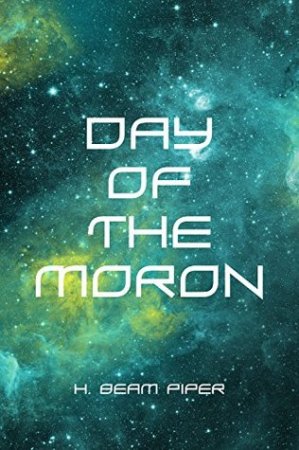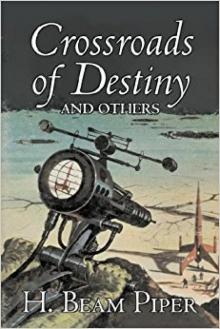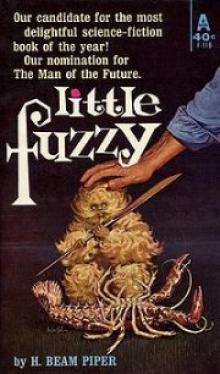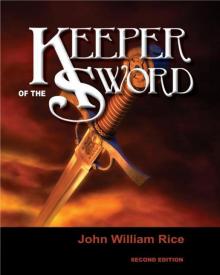- Home
- H. Beam Piper
Uller Uprising Page 3
Uller Uprising Read online
Page 3
II
THE FLUORINE PLANET
1. THE STAR AND PLANET
The planet named Niflheim is the fourth planet of Nu Puppis, rightangle 6:36, declension-43:09; B8 type star, blue-white and hot, 148light years distant from Earth, which will require a speed in excessof light to reach it.
Niflheim is 462,000,000 miles from its primary, a little less than thedistance of Jupiter from our sun. It thus does not receive too great atotal amount of energy, but what it does receive is of high potential,a large fraction of it being in the ultra-violet and higherfrequencies. (Watch out for really super-special sunburn, etc., onunwarned personnel.)
The gravity of Niflheim is approximately 1 g, the atmospheric pressureapproximately 1 atmosphere, and the average ambient temperatureabout-60 deg.C;-76 deg.F.
2. ATMOSPHERE
The oxidizer in the atmosphere is free fluorine (F_{2}) in a ratherlow concentration, about 4 or 5 percent. With it appears a madcollection of gases. There are a few inert diluents, such as N_{2}(nitrogen), argon, helium, neon, etc., but the major fraction consistsof CF_{4} (carbon tetrafluoride), BF_{3} (boron trifluoride), SiF_{4}(silicon tetrafluoride), PF_{5} (phosphorous pentafluoride), SF_{6}(sulphur hexafluoride) and probably others. In other words, thefluorides of all the non-metals that can form fluorides. Thephosphorous pentafluoride rains out when the weather gets cold. Thereis also free oxygen, but no chlorine. That would be liquid except invery hot weather. It sometimes appears combined with fluorine inchlorine trifluoride. The atmosphere has a slight yellowish tinge.
3. SOIL AND GEOLOGY
Above the metallic core of the planet, the lithosphere consistsexclusively of fluorides of the metals. There are no oxides, sulfides,silicates or chlorides. There are small deposits of such things asbromine trifluoride, but these have no great importance. Sincefluorides are weak mechanically, the terrain is flattish. Nothingtough like granite to build mountains out of. Since the fluoride ionis colorless, the color of the soil depends upon the predominant metalin the region. As most of the light metals also have colorless ions,the colored rocks are rather rare.
4. THE WATERS UNDER THE EARTH
They consist of liquid hydrofluoric acid (HF). It melts at-83 deg.C andboils at 19.4 deg.C. In it are dissolved varying quantities of metallicand non-metallic fluorides, such as boron trifluoride, sodiumfluoride, etc. When the oceans and lakes freeze, they do so from thebottom up, so there is no layer of ice over free liquid.
5. PLANTS AND PLANT METABOLISM
The plants function by photosynthesis, taking HF as water from thesoil, and carbon tetrafluoride as the equivalent of carbon dioxidefrom the air to produce chain compounds, such as:
H H H H | | | |--C--C--C--C-- | | | | F F F F
and at the same time liberating free fluorine. This reaction couldonly take place on a planet receiving lots of ultra-violet because somuch energy is needed to break up carbon tetrafluoride andhydrofluoric acid. The plant catalyst (doubling for the magnesium inchlorophyll) is nickel. The plants are colored in various ways. Theyget their metals from the soil.
6. ANIMALS AND ANIMAL METABOLISM
Animals depend upon two main reactions for their energy, and for theconstruction of their harder tissues. The soft tissues are about thesame as the plant molecules, but the hard tissues are produced by thereaction:
H H H F F F | | | | | |--C--C--C-- + F_{2} --> --C--C--C-- + HF | | | | | | F F F F F F
resulting in a teflon boned and shelled organism. He's going to betough to do much with. Diatoms leave strata of powdered teflon. Themain energy reaction is:
H H H | | |--C--C--C-- ... + F_{2} --> CF_{4} + HF | | | F F F
The blood catalyst metal is titanium, which results in colorlessarterial blood and violet veinous, as the titanium flips back andforth between tri and tetra-valent states.
7. EFFECT ON INTRUDING ITEMS
Water decomposes into oxygen and hydrofluoric acid. All organic matter(earth type) converts into oxygen, carbon tetrafluoride, hydrofluoricacid, etc., with more or less speed. A rubber gas mask lasts about anhour. Glass first frosts and then disappears. Plastics act likerubber, only a little slower. The heavy metals, iron, nickel, copper,monel, etc., stand up well, forming an insoluble coat of fluorides atfirst and then doing nothing else.
8. WHY GO THERE?
Large natural crystals of fluorides, such as calcium difluoride,titanium tetrafluoride, zirconium tetrafluoride, are extremely usefulin optical instruments of various forms. Uranium appears as uraniumhexafluoride, all ready for the diffusion process. Compounds of suchnon-metals as boron are obtainable from the atmosphere in high puritywith very little trouble. All metallurgy must be electrical. There areconsiderable deposits of beryllium, and they occur in highconcentration in its ores.

 The Edge of the Knife
The Edge of the Knife Genesis
Genesis A Slave is a Slave
A Slave is a Slave Last Enemy
Last Enemy Uller Uprising
Uller Uprising Ministry of Disturbance
Ministry of Disturbance Time and Time Again
Time and Time Again The Mercenaries
The Mercenaries Police Operation
Police Operation He Walked Around the Horses
He Walked Around the Horses Time Crime
Time Crime Dearest
Dearest Day of the Moron
Day of the Moron Crossroads of Destiny
Crossroads of Destiny Graveyard of Dreams
Graveyard of Dreams The Cosmic Computer
The Cosmic Computer Ullr Uprising
Ullr Uprising Operation R.S.V.P.
Operation R.S.V.P. Rebel Raider
Rebel Raider Murder in the Gunroom
Murder in the Gunroom Space Viking
Space Viking The Answer
The Answer A Planet for Texans (aka Lone Star Planet)
A Planet for Texans (aka Lone Star Planet) Little Fuzzy
Little Fuzzy Four-Day Planet
Four-Day Planet Little Fuzzy f-1
Little Fuzzy f-1 Keeper
Keeper The H. Beam Piper Megapack
The H. Beam Piper Megapack H. Beam Piper
H. Beam Piper Lord Kalvan of Otherwhen
Lord Kalvan of Otherwhen Fuzzy Sapiens f-2
Fuzzy Sapiens f-2 Fuzzies and Other People f-3
Fuzzies and Other People f-3 TIME PRIME
TIME PRIME Fuzzy Sapiens
Fuzzy Sapiens Lord Kalvan of Otherwhen k-1
Lord Kalvan of Otherwhen k-1 The Second H. Beam Piper Omnibus
The Second H. Beam Piper Omnibus